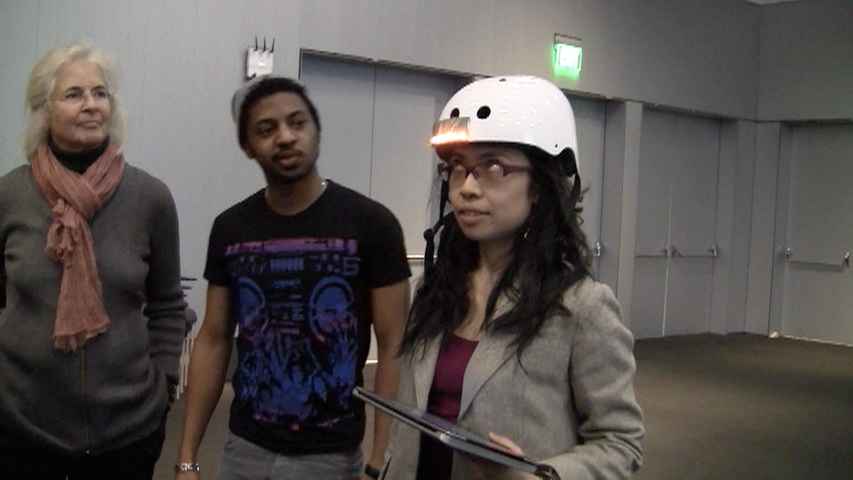Projects now. Publications soon...
Where The Hel

"Where The Hel" is a pair of helmets: a 'Plain' helmet and a 'Funky,' 3D printed helmet. The Plain helmet visualizes proximity to the Funky helmet as a function of signal strength, via an LED light strip. The Funky helmet contains an Xbee and a GPS Radio. Its position is tracked via a web app. The wearer of the Plain helmet can track the Funky one via the web app and the LED strip on his helmet. These helmets are potential iterations towards a more developed HADR (Humanitarian Assistance and Disaster Relief) helmet system.
dev notes
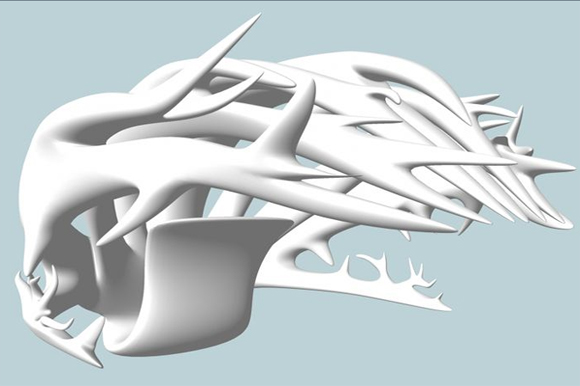
The Funky helmet model.
I 3D-printed the Funky helmet and bundle an Xbee radio and GPS device into it. An image of the model is above. It holds the iPod Touch (GPS module) and Arudino FIO in the back hook.
I modeled the helmet in Maya and scaled it in Pleasant3D. Here's the STL model.
A second Xbee/GPS set is bundled into a "plain helmet." A cyclist wearing the plain helmet was charged with finding a cyclist wearing the pretty helmet. The major phases for this project involved setting up Xbee communication and indicating signal strength between them, setting up GPS tracking on the helmets, and printing the Funky helmet. Since I didn't yet have access to raw GPS radios, I used an iOS device for the purposes of this project.
click to play demo video
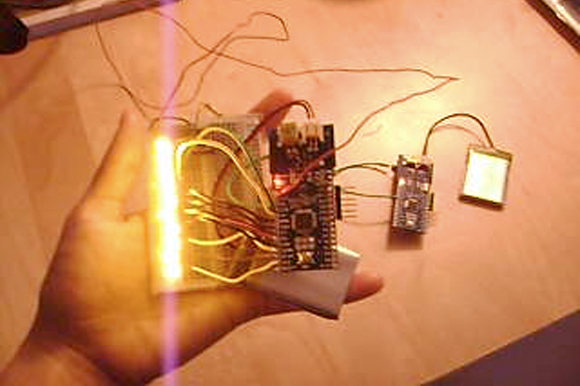
A light gauge connected to an Arduino Fio.
I used a couple of Series 1 Xbee radios combined with a couple of Arduino Fio boards. Arduino Fios are built for Xbee radios, no additional shields required.
R-click to download Helmet Emitter Arduino Sketch (for funky helmet)
R-click to download Helmet Receiver Arduino Sketch (for plain helmet)
Right now, this sketch maps about 5 meters to a 10-LED series (values of up to 50 from the XBee RSSI pin). The sketch can be modified to map up to 200 meters (values of up to 200 from the XBee RSSI pin).
The sketch is also a little noisy at the moment. To-Do: dealing with zero values (which are outputted seemingly randomly at all ranges) and perhaps decreasing frequency of processing.
http://log.liminastudio.com/itp/physical-computing/measuring-xbee-signal-strength-from-the-rssi-pin
http://funnel.cc/Hardware/FIO
http://itp.nyu.edu/physcomp/Tutorials/XbeeBasics
http://bildr.org/2011/04/arduino-xbee-wireless/
http://www.arduino.cc/en/Main/ArduinoBoardFio
http://arduino.cc/en/Main/ArduinoBoardFioTips
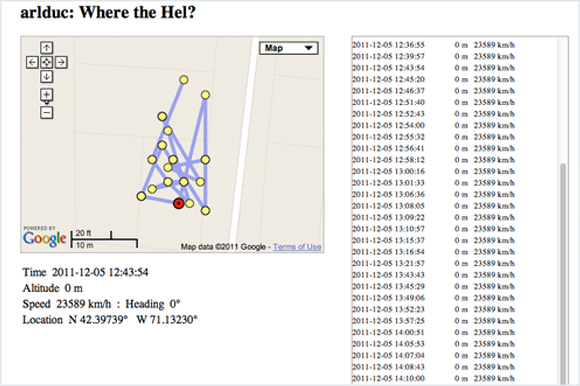
Web App Screenshot.
I set up a quick app on my iPod touch to be tracked using its internal GPS module. I'm using a GPS data service called InstaMapper. It's sending its position every few minutes. It's a little spooky to be seeing my tracking visualized.... ack!
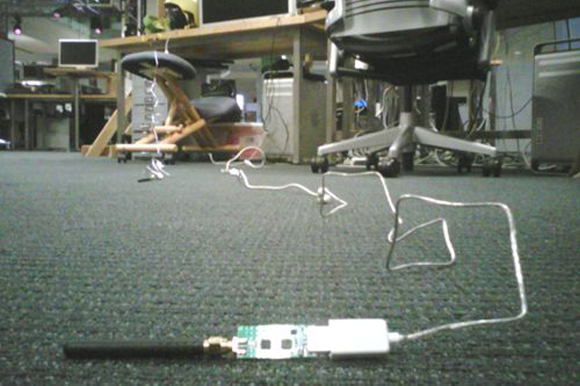
NOTES ON EARLIER TESTS
In earlier tests for this project, I tried working with "Zigboards," or zigbee boards with additional control, by Brian Mayton.
I tested the Zigboards using this script, a simple adjustment of the python script on Brian's wiki. So far so good.
Then I attached the Zigboards to the Mac with super long USB cables. That worked ok, though sometimes there were disconnection issues. However, the long USB cables don't provide enough slack to really change link quality index or energy detection when the Zigboards are moved around the room. Also, when I tried to connect the Zigboard to a USB wallwart, its green light starts blinking and it won't connect. Brian explained that the networking protocol is still a work in progress.
At any rate, the Mac Pro is too big to strap to a bike helmet! So I set up the Intel Atom to possibly run the Zigboards. I'm trying to get a hold of some even smaller computers (Raspberry Pi) to run them.
2 Questions about the Atom (answered later by Brian).
Do you add a hard drive to it so that it won't need to boot from the USB stick every time?
How did you de-couple the compute module from the carrier? Also, do you have any spare Atoms already encased in your altoids-like boxes?
To these questions, Brian explained that the Altoids tin is a completely different platform called Fish River Island (FRI); it's not just a compute module in a box.
I'm now struggling with deciding on next steps for my helmet project, especially as it pertains to the remaining time in the semester. I would ideally like to have helmet-based mobile transceivers, without base-stations, outputting proximity data that is visualized by some LEDs.
It seems that it may be more straightforward to do this with some Arduino Xbees. On the other hand, I think the zigboards are really cool and I'd like to contribute to the project if there's a need. UPDATE: I'm ordering some Arduino FIO boards, XBee series 1 radios, and Parallax GPS modules for the next round.
END NOTES ON EARLIER TESTS
Thanks to Joe Paradiso and his Location-Aware Tech class, for which this project was constructed. Thanks to Alex Simoes and Nan Zhao for starring in the concept video. Thanks also to Glorianna Davenport, Nick Pennycooke, Shaun Salzburg, Dan Novy, Gershon Dublon, and Brian Mayton for appearing in the demo video.

